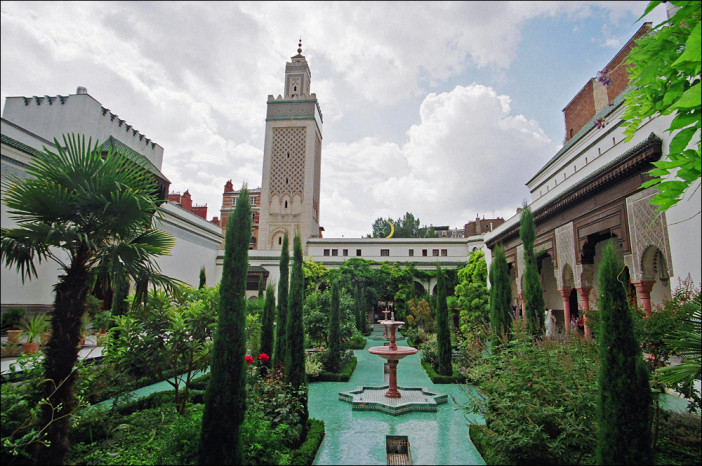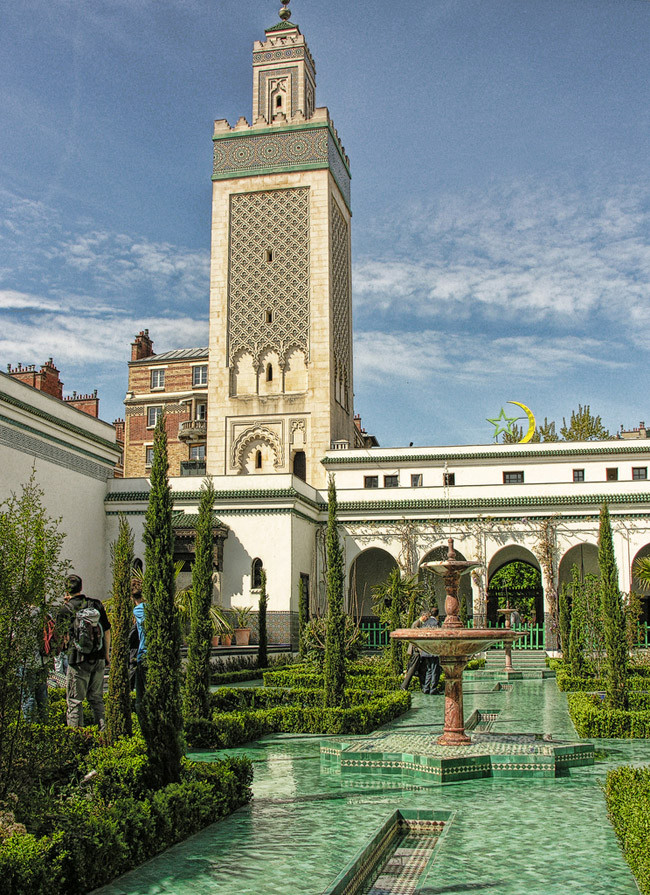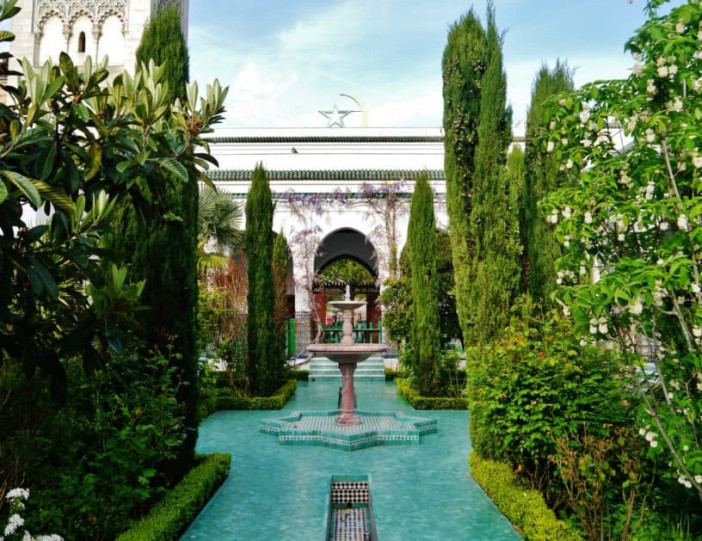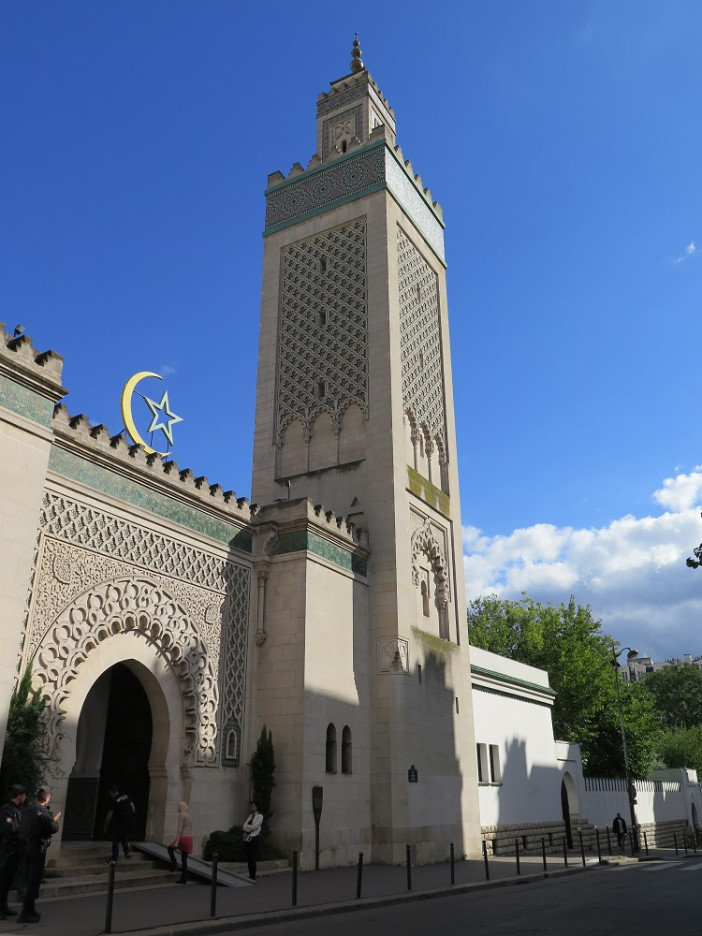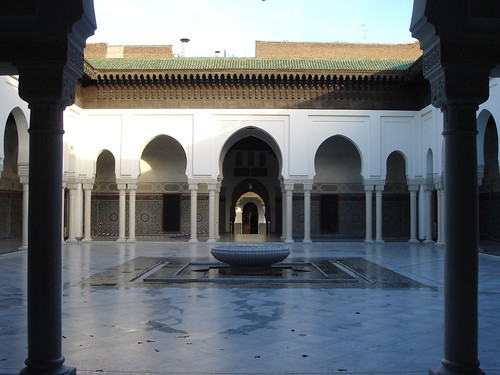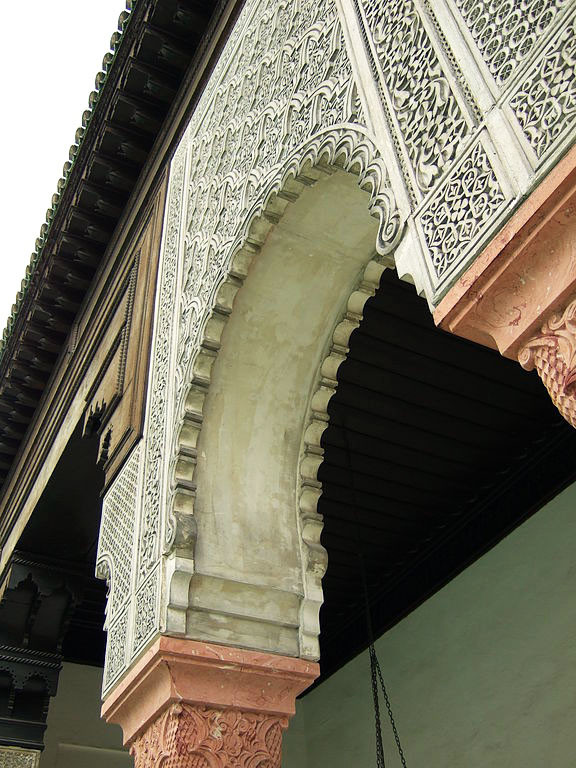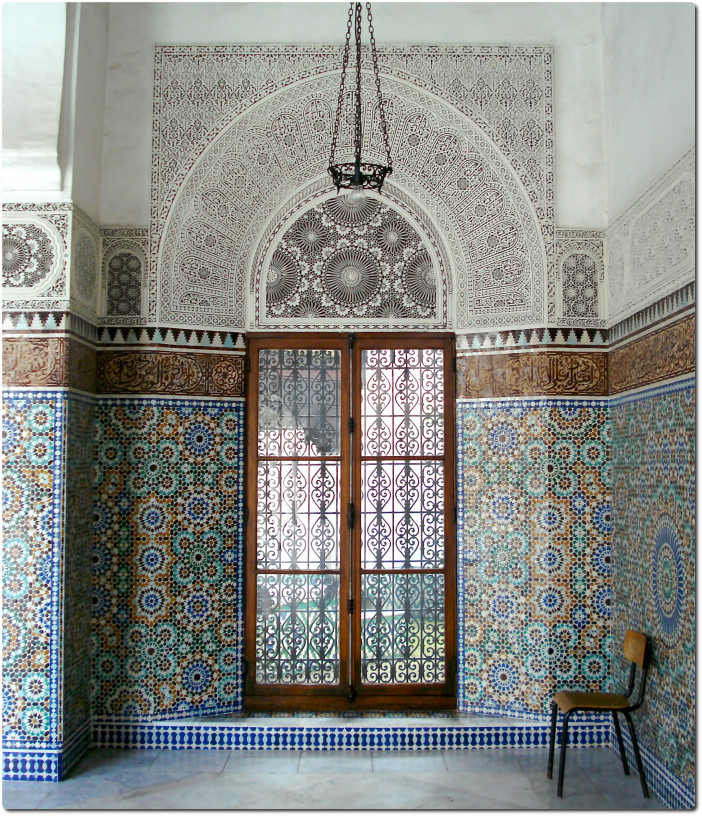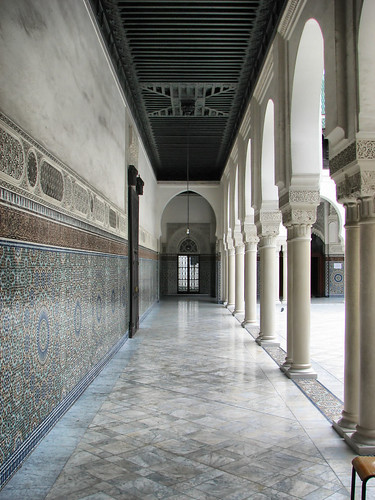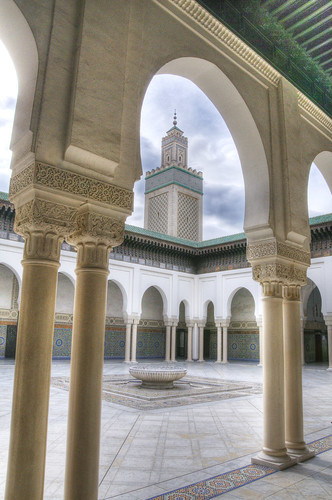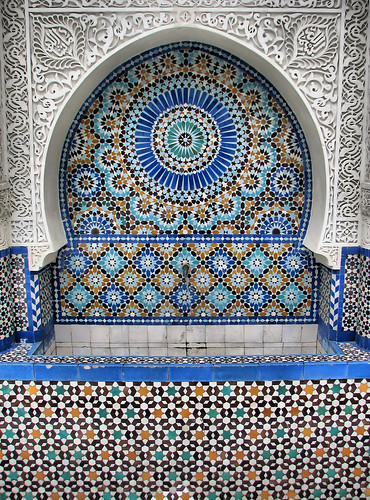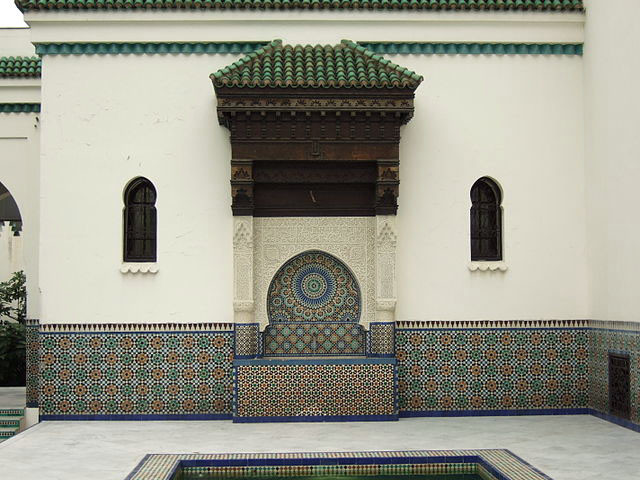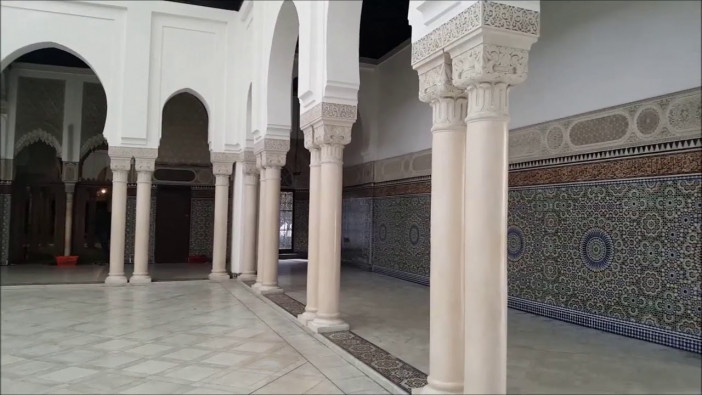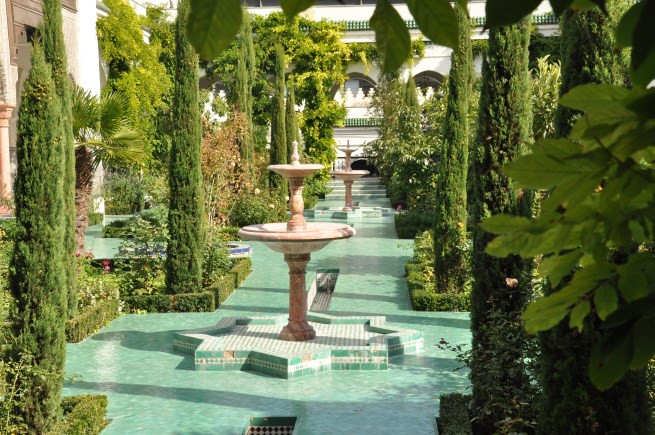Grand Mosque in Paris
History
La grande mosquée de Paris, is the oldest mosque in mainland France. The Mosque was inaugurated in the interwar years in the 1920’s. Founded by Si Kaddour Benghabrit, an impressive figure, who served as a state worker or fonctionnaire at the Quai d’Orsay.
Description
The Mosque serves as an important symbol and reminder, promoting the visibility of muslims in France. As well as being a popular tourist destination and impressive display of exotic grandeur, The Great Mosque of Paris covers an area of 7,500 square meters, and comprises:
A prayer room whose decoration is inspired by many parts of the Muslim world
A Madrasa (school)
A library
A conference room
Arab gardens covering an area of 3,500 square meter
Annexes of a restaurant, tea room, hammam, and shops
The Mosque, along with the Islamic Center, are listed in the supplementary inventory of Historic Monuments by the decree of 9 December 1983. The edifice is filed under the label of “Twentieth Century Patrimony".The Great Mosque of Paris can accommodate up to 1,000 people, and authorizes access to women, and provides confessional rooms as well as access for handicapped persons. The Great Mosque of Paris is inspired by Spanish-Moorish styles of architecture. It was actually modeled on an existing Mosque in Fez (the el-Qaraouiyyîn Mosque). Its architecture is unique in Paris. It also reminds me of the Alcazar in Seville, similarly grand with intricate paneling and mosaics.For all intricate and decorative features, experienced and specialised artisans from North Africa were commissioned to work with traditional materials, to achieve the desired effect.
Mosque’s minaret measures 33 metres tall. It was inspired by the Zitouna Mosquein Tunisia. Marshall Lyautey inaugurated its construction in 1922, claiming that the minaret would soar into the sky of Île-de-France as one more prayer alongside all the other Catholic towers, such as Notre Dame, but they would feel no jealousy towards it.
Today, the Grand Mosque plays an important role in French social society, promoting the visibility of Islam and Muslims. The mosque was assigned to Algeria in 1957 by the French Foreign Minister. The Paris Mosque serves as the head mosque for French mosques and is currently led by mufti Dalil Boubakeur, who has served as rector since 1992. In 1993 the Institut Al-Ghazali was founded, a religious seminary for the training of imams and Muslim chaplains.In 1994, Charles Pasqua, then the Minister of the Interior in charge of Religion, gave the Grand Mosque the authority of certifying meat as halal.
On 12 December 2011, an official ceremony marked the start of the construction of a retractable roof covering the great patio facing the prayer hall of the Great Mosque. This important project, long awaited for many years by its congregants in order to protect them during inclement weather, was an important feature of its original conception in 1922–26.
In November 2012, a prayer room was set up in Paris by a member of the group 'Homosexual Muslims of France' Ludovic-Mohamed Zahed. The opening has been condemned by the Grand Mosque of Paris.
In December 2013, the group Les Femmes dans la Mosquée (Women in the Mosque) demanded from the administration the right to pray in the same room as men, having been excluded from it and relegated to the entrance foyer. For the spokesperson of the movement Hanane Karimi, “The previous policy reflects the organization of the Muslim community along certain conventions today, that women have no place there; they have become invisible."
During the administration of Bertrand Delanoë, some controversies have arisen, such as those who want to give an emphyteutic lease to the Société des Habous and sacred places of Islam. In 2013, the office of the mayor of Paris Anne Hidalgo refused permission of the construction of a second building for the Institut des Cultures d’Islam (Institute of Muslim Cultures), citing the 1905 Law of the separation of Church and State.
The Grand Mosque of Paris urged voters to "follow the path of hope" by voting for Emmanuel Macron, instead of Marine Le Pen.
Legal Status
Since 1921, the Great Mosque has been under the authority of the Société des Habous et lieux saints d l'Islam, an association regulated by the Law of 1901, owner of the building following its donation by the city of Paris. In the 1980s the Minister of the Interior Gaston Deferre withdrew the guardianship of the Mosque from the Ministry and the city of Paris, an act which has since permitted Algeria to finance a third of the budget of the mosque (in 2015, this budget totalled 1.8 million euros).
Even if the mosque is legally independent, it remains religiously and culturally linked to Algeria, which exercises an unwritten right to the nomination of its rector; although, in 2015, Algeria announced officially the start of procedures for the acquisition of the property of the Great Mosque of Paris.
Details
الموقع
2bis Place du Puits de l'Ermite, 75005 Paris, France
عدد المصليين
1000
المعماري
تاريخ البناء
1922-1926
Area
7500 sqm
الرسومات المعمارية
الخريطة
History
La grande mosquée de Paris, is the oldest mosque in mainland France. The Mosque was inaugurated in the interwar years in the 1920’s. Founded by Si Kaddour Benghabrit, an impressive figure, who served as a state worker or fonctionnaire at the Quai d’Orsay.
Description
The Mosque serves as an important symbol and reminder, promoting the visibility of muslims in France. As well as being a popular tourist destination and impressive display of exotic grandeur, The Great Mosque of Paris covers an area of 7,500 square meters, and comprises:
A prayer room whose decoration is inspired by many parts of the Muslim world
A Madrasa (school)
A library
A conference room
Arab gardens covering an area of 3,500 square meter
Annexes of a restaurant, tea room, hammam, and shops
The Mosque, along with the Islamic Center, are listed in the supplementary inventory of Historic Monuments by the decree of 9 December 1983. The edifice is filed under the label of “Twentieth Century Patrimony".The Great Mosque of Paris can accommodate up to 1,000 people, and authorizes access to women, and provides confessional rooms as well as access for handicapped persons. The Great Mosque of Paris is inspired by Spanish-Moorish styles of architecture. It was actually modeled on an existing Mosque in Fez (the el-Qaraouiyyîn Mosque). Its architecture is unique in Paris. It also reminds me of the Alcazar in Seville, similarly grand with intricate paneling and mosaics.For all intricate and decorative features, experienced and specialised artisans from North Africa were commissioned to work with traditional materials, to achieve the desired effect.
Mosque’s minaret measures 33 metres tall. It was inspired by the Zitouna Mosquein Tunisia. Marshall Lyautey inaugurated its construction in 1922, claiming that the minaret would soar into the sky of Île-de-France as one more prayer alongside all the other Catholic towers, such as Notre Dame, but they would feel no jealousy towards it.
Today, the Grand Mosque plays an important role in French social society, promoting the visibility of Islam and Muslims. The mosque was assigned to Algeria in 1957 by the French Foreign Minister. The Paris Mosque serves as the head mosque for French mosques and is currently led by mufti Dalil Boubakeur, who has served as rector since 1992. In 1993 the Institut Al-Ghazali was founded, a religious seminary for the training of imams and Muslim chaplains.In 1994, Charles Pasqua, then the Minister of the Interior in charge of Religion, gave the Grand Mosque the authority of certifying meat as halal.
On 12 December 2011, an official ceremony marked the start of the construction of a retractable roof covering the great patio facing the prayer hall of the Great Mosque. This important project, long awaited for many years by its congregants in order to protect them during inclement weather, was an important feature of its original conception in 1922–26.
In November 2012, a prayer room was set up in Paris by a member of the group 'Homosexual Muslims of France' Ludovic-Mohamed Zahed. The opening has been condemned by the Grand Mosque of Paris.
In December 2013, the group Les Femmes dans la Mosquée (Women in the Mosque) demanded from the administration the right to pray in the same room as men, having been excluded from it and relegated to the entrance foyer. For the spokesperson of the movement Hanane Karimi, “The previous policy reflects the organization of the Muslim community along certain conventions today, that women have no place there; they have become invisible."
During the administration of Bertrand Delanoë, some controversies have arisen, such as those who want to give an emphyteutic lease to the Société des Habous and sacred places of Islam. In 2013, the office of the mayor of Paris Anne Hidalgo refused permission of the construction of a second building for the Institut des Cultures d’Islam (Institute of Muslim Cultures), citing the 1905 Law of the separation of Church and State.
The Grand Mosque of Paris urged voters to "follow the path of hope" by voting for Emmanuel Macron, instead of Marine Le Pen.
Legal Status
Since 1921, the Great Mosque has been under the authority of the Société des Habous et lieux saints d l'Islam, an association regulated by the Law of 1901, owner of the building following its donation by the city of Paris. In the 1980s the Minister of the Interior Gaston Deferre withdrew the guardianship of the Mosque from the Ministry and the city of Paris, an act which has since permitted Algeria to finance a third of the budget of the mosque (in 2015, this budget totalled 1.8 million euros).
Even if the mosque is legally independent, it remains religiously and culturally linked to Algeria, which exercises an unwritten right to the nomination of its rector; although, in 2015, Algeria announced officially the start of procedures for the acquisition of the property of the Great Mosque of Paris.


